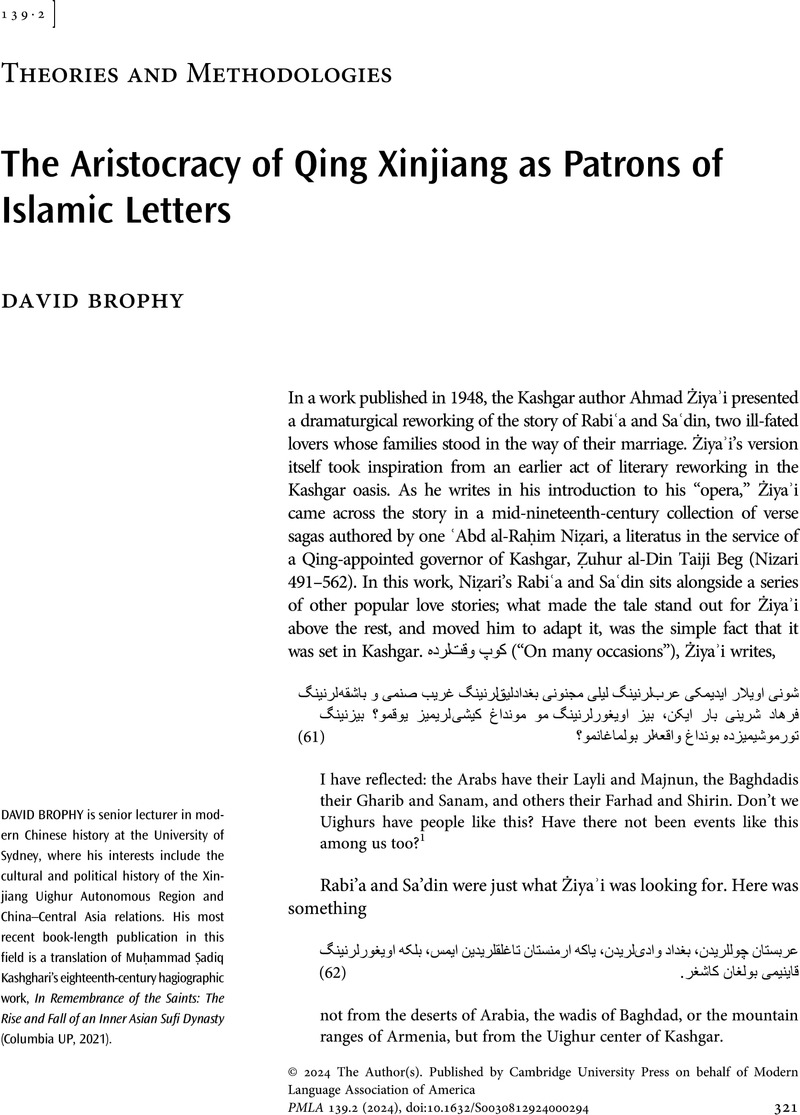No CrossRef data available.
Article contents
The Aristocracy of Qing Xinjiang as Patrons of Islamic Letters
Published online by Cambridge University Press: 26 July 2024
Abstract
An abstract is not available for this content so a preview has been provided. Please use the Get access link above for information on how to access this content.

- Type
- Theories and Methodologies
- Information
- Copyright
- Copyright © 2024 The Author(s). Published by Cambridge University Press on behalf of Modern Language Association of America
References
Works Cited
Calzolaio, Francesco. “The Great Khan's Continent: On Taḥqīq and Rashīd al-Dīn's Discovery of China.” Journal of Early Modern History, vol. 27, 2023, pp. 289–303.CrossRefGoogle Scholar
Chen Yin-Yi [陳殷宜]. “清朝回疆王公出任阿奇木伯克的演變與成效—以喀什噶爾及葉爾羌兩城為例” [“Qingchao Huijiang wanggong churen Aqimu boke de yanbian yu chengxiao—yi Kashigaer ji Yeerqiang liangcheng wei li”]. 中科大學報 [Zhongke daxuebao], vol. 4, no. 1, 2017, pp. 37–64.Google Scholar
Çimen, Feyzi. “Molla Muhammed Timur'un Çağatayca Kelile ve Dimne Tercümesi.” FSM İlmî Araştırmalar, vol. 2, 2013, pp. 85–99.Google Scholar
Fletcher, J. “The Biography of Khwush Kipäk Beg (d. 1781) in the Wai-fan Meng-ku Hui-pu wang kung piao chuan.” Acta Orientalia Academiae Scientiarum Hungaricae, vol. 36, 1982, pp. 167–72.Google Scholar
Green, Nile. “From the Silk Road to the Railroad (and Back): The Means and Meanings of the Iranian Encounter with China.” Iranian Studies, vol. 48, no. 2, 2015, pp. 165–92.CrossRefGoogle Scholar
Hartmann, Martin. “Die osttürkischen Handschriften der Sammlung Hartmann.” Mittheilungen des Seminars für orientalische Sprachen, Berlin, vol. 7, no. 2, 1904, pp. 1–21.Google Scholar
Hemmat, K. L. “Children of Cain in the Land of Error: A Central Asian Merchant's Treatise on Government and Society in Ming China.” Comparative Studies of South Asia, Africa and the Middle East, vol. 30, no. 3, 2010, pp. 434–48.Google Scholar
ʿIsa, Muḥammad. ریاض المذکرین ترجمه سی [Riyaż al-Muzakkirin Tarjamasi]. 1218 [1803–04], Tashkent, IVANRUz no. 5717.Google Scholar
Kashghari, Muḥammad Ṣadiq. In Remembrance of the Saints: The Rise and Fall of an Inner Asian Sufi Dynasty. Translated by Brophy, David, Columbia UP, 2021.Google Scholar
Kho'jandiy, Tojir. Ғаройиби сипоҳ [G'aroyibi Sipoh]. Akademiyai Kamoli Khujandii, 1993.Google Scholar
Atsushi [河野敦史], Kono. “18 ~ 19 世紀における回部王公とべク制に関する一考察” [“18 ~ 19 seiki ni okeru kaibu ōkō to beku sei ni kansuru ichi kōsatsu”]. 日本中央アジア学会報 [Nihon Chūō Ajia gakkaihō], vol. 9, 2013, pp. 15–44.Google Scholar
Muginov, A. M. Описание уйгурских рукописей Института народов Азии [Opisanie uigurskikh rukopisei Instituta narodov Azii]. Institut narodov Azii Akademii nauk SSSR, 1962.Google Scholar
Muḥammad Nurullah, Muḥammad ʿAbdullah b.. شرح نزهت [Sharḥ-i Nuzhat]. 1140 [1727–28], Lund, Jarring Prov. 298.Google Scholar
Khamush, Mulla. ترجمه ٔ شاه نامه [Tarjama-i Shahnama]. 1194 [1780–81], Tashkent, IVANRUz no. 5009.Google Scholar
Newby, Laura. The Empire and the Khanate: A Political History of Qing Relations with Khoqand c. 1700–1860. Brill, 2005.CrossRefGoogle Scholar
Ostonaqulov, Ikromitdin. Муҳаммад Сиддиқ Рушдий ва унинг “Тазкират ул-авлиёи туркий” асари [Muḥammad Siddiq Rushdiy va uning “Tazkirat ul-avliyoi turkiy” asari]. Toshkent Islom Universiteti, 2007.Google Scholar
Papas, Alexandre. “Individual Sanctity and Islamization in the Ṭabaqāt Books of Jāmī, Navāʾī, Lāmiʿī, and Some Others.” Jāmī in Regional Contexts: The Reception of ʿAbd al-Raḥmān Jāmī's Works in the Islamicate World, ca. 9th/15th–14th/20th Century, edited by D'Hubert, Thibaut and Papas, , Brill, 2018, pp. 378–423.Google Scholar
Paul, Jürgen, editor. Katalog sufischer Handschriften aus der Bibliothek des Instituts für Orientalistik der Akademie der Wissenschaften, Republik Usbekistan. Franz Weiner Verlag, 2002.Google Scholar
Peacock, A. C. S. Islam, Literature and Society in Mongol Anatolia. Cambridge UP, 2019.CrossRefGoogle Scholar
Räshidi, Muhämmät Siddiq. سىددىقنامە [Siddiqnamä]. Shinjang Khälq Bash Näshriyati, 2006.Google Scholar
Rushdi, Muhạmmad Sịddiq. ترمه ٔ قابوس نامه [Tarjama-i Qabusnama]. 1201 [1786–87], Lund, Jarring Prov. 342.Google Scholar
Rushdi, Muhạmmad Sịddiq. تذکرت الاولیای ترکی [Taẕkirat al-Avliya-yi Turki]. 1194 [1780–81], Lund, Jarring Prov. 345.Google Scholar
Rushdi, Muhạmmad Sịddiq. تذکرت الاولیای ترکی [Taẕkirat al-Avliya-yi Turki]. 1194 [1780–81], Tashkent, IVANRUz no. 3161.Google Scholar
Rushdiy, Muhammad Siddiq. Авлиёлар султони / Туронлик валийлар [Avliyolar Sultoni / Turonlik valiylar]. Edited by Ikromiddin Ostonaqulov, Yang asr avlodi, 2004.Google Scholar
Sartori, Paolo. “From the Demotic to the Literary: The Ascendance of the Vernacular Turkic in Central Asia (Eighteenth–Nineteenth Centuries).” Eurasian Studies, vol. 18, 2020, pp. 213–54.CrossRefGoogle Scholar
Stöcker-Parnian, Barbara. Jingtang Jiaoyu: Die Bücherhallen Erziehung: Entstehung und Entwicklung der islamischen Erziehung in den chinesischen Hui-Gemeinden vom 17.–19. Jahrhundert. Peter Lang, 2003.Google Scholar
Toutant, Marc. “De-Persifying Court Culture: The Khanate of Khiva's Translation Program.” The Persianate World: The Frontiers of a Eurasian Lingua Franca, edited by Green, Nile, U of California P, 2019, pp. 243–57.Google Scholar
Weil, Dror. “Islamicated China: China's Participation in the Islamicate Book Culture during the Seventeenth and Eighteenth Centuries.” Intellectual History of the Islamicate World, vol. 4, 2016, pp. 36–60.CrossRefGoogle Scholar
Żiyaʾi, Aḥmad. توزوماس چچکلر [“Tozumas Chichäklär”]. تورکستان ادبیاتیدن پارچه لر [Türkistan Adabiyatidan parchalar], edited by Islami Turkistani, Muḥammad Amin, Maṭbaʿat ʿAṭaya, 1379 [1960], pp. 16–120.Google Scholar




